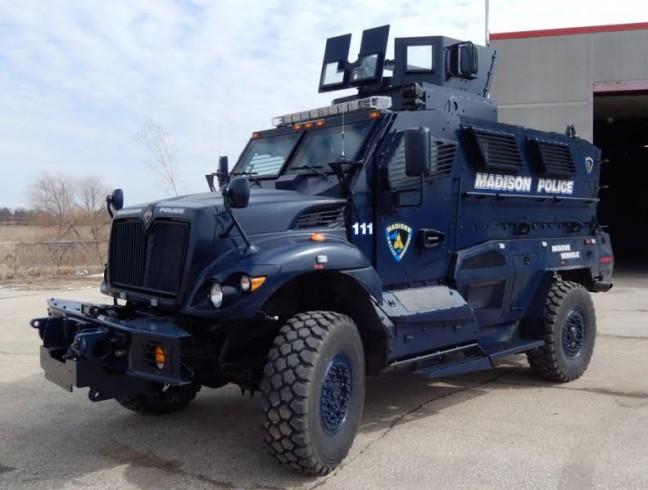While local police forces nationwide face scrutiny for their use of military equipment, Madison Police Chief Mike Koval prefers to leave the riot gear at the station.
The militarization of local police forces has become a national debate following protests in Ferguson, Missouri, where police were outfitted in military riot gear from the U.S. Department of Defense. Madison has seen its share of protests, but Koval said the Madison Police Department responds with a different mindset.
“When you’re in a community like our own, vibrant with thinkers and thousands of young students that, I hope, are learning to challenge authority, we can’t be a traditional call and response sort of operation,” Koval said. “You can’t start engaging someone by trying to talk through a kevlar helmet with a glass visor. It sends the wrong message.”
Koval said MPD is just as equipped as any other local police force in terms of military equipment, but differs in how it actually uses that equipment. MPD does own riot gear, or hard gear, as well as an Armored Rescue Vehicle, which Koval said is only employed to protect citizens from threats like an active shooter.
MPD spokesperson Joel DeSpain said utilizing hard gear is an absolute last resort. Despain said during the collective bargaining law protests in 2011, which brought about 100,000 people to the Capitol square, MPD stressed that their officers stay in soft gear the entire time.
“Our whole philosophy is based on being out in the community, being one with the community and working with the community,” DeSpain said. “Our job was to keep the streets safe for democracy and to do so in such a way that everybody stays safe.”
The Ferguson protests came after a white police officer shot and killed 18-year-old Michael Brown, an African American who was unarmed. There was no video available of the shooting.
In an effort to increase transparency and avoid situations like the one in Ferguson, Ald. Scott Resnick, District 8, is pushing for the city’s officers to be equipped with body cameras that would capture and save footage of any altercations.
Resnick asked for a report from MPD to explore the costs and benefits of getting the cameras, which would range between $300 and $500 each. He estimated the total cost for the project to be $250,000.
“There’s been a national outcry for both demilitarization of police departments and other issues such as body cameras,” Resnick said. “I think this is the right time to start exploring these policies, and community leaders have been asking for things like body cameras to be on our radar screen.”
Resnick said the cameras could be invaluable in both decreasing the number of false accusations made against officers as well as protecting the public by having reviewable evidence of police interactions.
Koval said these cameras are something MPD has been looking at for some time, though it has not become a public discussion until recently.
“The whole issue of body cams is not an issue of if we are amenable to seeing it go forward, it is more of an issue of when,” Koval said. “There’s no doubt in my mind that in the next three to five years our entire force will have some form of body camera attached to them.”
Right now the cost of similar proposals is the problem, DeSpain said. Aside from the cost of the individual cameras, a system for retaining all of the video and the ability to pull from stored footage is also necessary, and DeSpain said the entire project is just too expensive at the moment.
For the time being, Koval said working with his challenged neighborhoods is his top priority. From a budgetary standpoint, Koval said the cameras are not first choice.
“For me, I’d rather have more neighborhood officers in some of our challenged neighborhoods than asking for more money in the form of technology grants of that kind, only because I’m doing what’s most important now,” Koval said. “Yes, the cameras are a good idea, but right now I believe the community trusts us, and so I think they’d rather see more neighborhood officers that are engaging our communities in positive ways.”


















